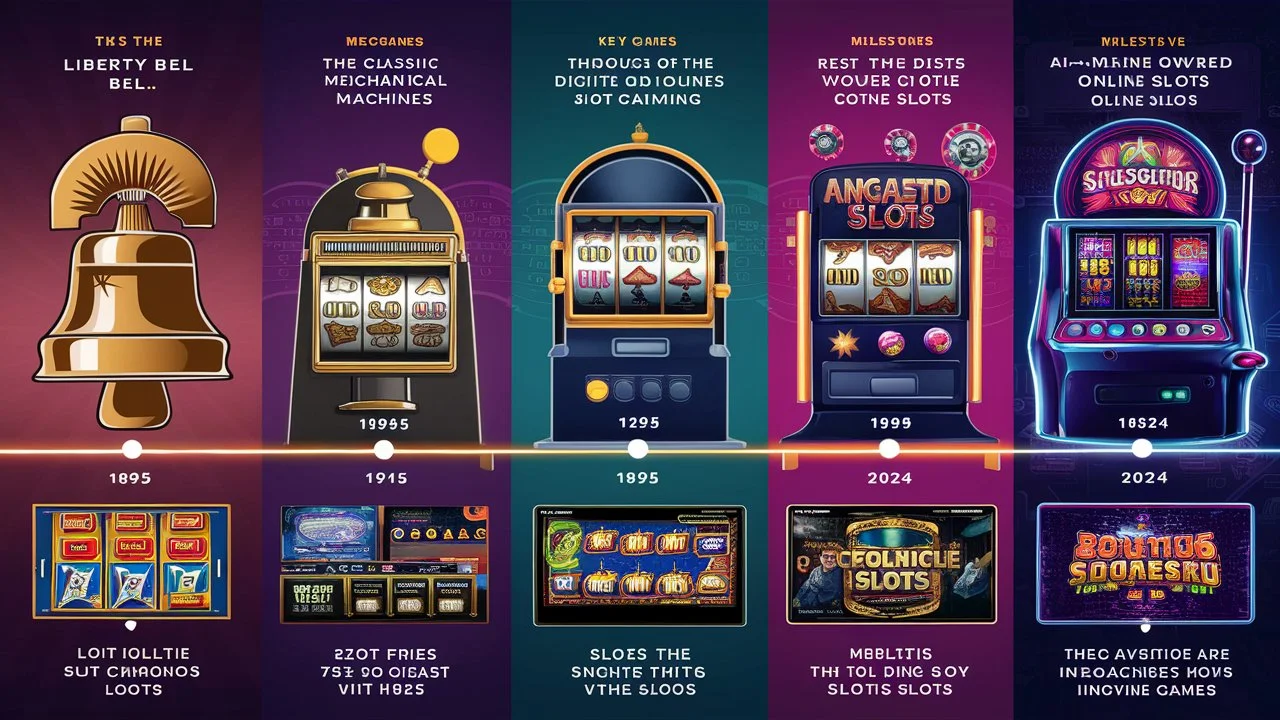The Evolution of Slot Games: Slot games have undergone a remarkable transformation since Charles Fey invented the Liberty Bell machine in 1895, evolving from simple mechanical devices to sophisticated digital experiences that captivate millions of players worldwide. This article chronicles the journey of slot games through time, exploring the technological advancements, cultural shifts, and regulatory changes that have shaped the industry. We’ll examine the key milestones in slot game evolution, including:
- The transition from mechanical to electromechanical and video slots
- The rise of online and mobile gaming platforms
- The introduction of progressive jackpots and themed games
- The integration of social media elements and virtual reality
- The impact of artificial intelligence and big data on game design and player experience
The Birth of Slot Machines: Liberty Bell and Early Mechanical Slots
The story of slot machines begins in San Francisco in 1895. Charles Fey, a car mechanic, created the Liberty Bell. This first true slot machine had three spinning reels. Each reel had symbols like horseshoes, diamonds, spades, hearts, and the Liberty Bell.

The Liberty Bell was simple but revolutionary. Players inserted a nickel and pulled a lever to spin the reels. If three Liberty Bells lined up, the player won the top prize of 50 cents. The machine’s success was instant. Fey couldn’t keep up with demand.
Other inventors soon made their own versions. Herbert Mills introduced the Operator Bell in 1907. It used fruit symbols like cherries and melons. These fruit symbols are still common in modern slots.
Early slot machines were fully mechanical. They used springs and gears to spin the reels. The payout was also mechanical. Coins would fall into a tray when players won.
Slots quickly spread across the United States. They were found in bars, cigar shops, and bowling alleys. But legal issues soon arose. Many places banned slot machines. This led to the creation of gum-dispensing machines. These machines gave out gum with every spin to skirt gambling laws.
The early mechanical era laid the foundation for all future slots. It introduced key features like multiple pay lines and different symbol combinations. These concepts still drive slot game design today.
Electromechanical Era: The Rise of Vegas and Casino Culture

The 1960s marked a major shift in slot machine technology. In 1963, Bally developed the first electromechanical slot machine, Money Honey. This new design kept mechanical reels but added electrical components.
The 1960s marked a major shift in slot machine technology. In 1963, Bally developed the first electromechanical slot machine, Money Honey. This new design kept mechanical reels but added electrical components.
Money Honey could operate without human help. Its bottomless hopper allowed automatic payouts of up to 500 coins. This was a game-changer. It made slot machines more reliable and able to handle larger payouts.
Las Vegas embraced these new machines. Casinos filled their floors with electromechanical slots. The flashy lights and sounds of these machines became a symbol of Vegas. They drew in crowds and helped build the city’s reputation as a gambling mecca.
Slot machines became the most popular game in casinos. They were easy to play and offered the chance of big wins, and casinos made more money from slots than from any other game.
The rise of slots changed casino culture. Before, tabletop games like blackjack and roulette were king. Now, rows of slot machines dominated casino floors. Casinos designed their layouts to showcase these machines.
New features appeared during this era. Multiple coin play allowed for bigger bets and payouts. Bonus rounds added excitement. Some machines even had multiple games in one cabinet.
As slots became more complex, so did strategies for beating them. Some players tried to track machine patterns, and others developed systems to predict payouts. But in the end, slots remained games of chance.
The electromechanical era set the stage for even bigger changes. It showed how technology could transform gambling and entertainment.
Video Slots: The Digital Revolution Begins
The late 1970s brought a new era in slot gaming. Fortune Coin Co. introduced the first video slot machine in 1976. It used a modified 19-inch Sony TV for the display. Players in Las Vegas were skeptical at first. They missed the physical reels.
But video slots soon won people over. They offered more exciting graphics and sound effects. They could also have more reels and pay lines. This meant more ways to win and bigger jackpots.
In 1996, WMS Industries Inc. released “Reel ‘Em In.” This was the first video slot with a second-screen bonus round, in which players could win extra money in a separate game. This feature became hugely popular.
Video slots allowed for more creative themes. Games could now be based on TV shows, movies, and celebrities. This variety appealed to a wider range of players.
The technology also made it easier to add new features. Wild symbols, scatter pays, and free spins became common. These added depth to the gameplay.
Random Number Generators (RNGs) became crucial. These computer programs ensured fair play by making sure each spin was random and not predictable.
Video slots changed how casinos looked. The bright screens and flashy animations drew more attention. Casinos started grouping machines by theme or jackpot size.
By the end of the 1990s, video slots dominated most casinos, paving the way for even more advanced games. The digital revolution in slot gaming has firmly taken hold.
Online Slots: Gambling Goes Digital
The late 1990s saw another big change in slot gaming. The internet brought slots into people’s homes. Microgaming launched the first online casino software in 1994. Soon after, online slots appeared.

Early online slots were simple and mimicked physical machines. But they quickly evolved. Developers could now create games without physical limits, leading to more reels, pay lines, and bonus features.
Online slots offered benefits over land-based games. Players can enjoy games 24/7 from anywhere. There was a wider variety of games to choose from. Betting limits were often lower, appealing to casual players.
The online environment also allowed for new features. Multiplayer slots let people play together, and progressive jackpots linked games across many casinos, creating huge, life-changing prizes.
Security became a major focus. Online casinos use encryption to protect player data. They also had to prove their games were fair. This led to the rise of independent testing agencies.
As online slots grew, so did regulations. Different countries took different approaches. Some fully embraced online gambling, while others banned it outright, creating a complex legal landscape.
Online slots changed how people thought about gambling. It was no longer just a casino activity. Now, it was a form of home entertainment. This shift brought new players to the market.
By the early 2000s, online slots were a booming industry. They set the stage for mobile gaming and continue to evolve today. The digital age of slot gaming had truly begun.
Mobile Slots: Gaming on the Go
The rise of smartphones in the late 2000s brought slot gaming to our pockets. Mobile slots first appeared on simple feature phones. But they really took off with the iPhone and Android devices.
Early mobile slots were basic. They had to work on small screens and slow networks. But as phones improved, so did the games. High-resolution displays and faster internet made rich graphics possible.
Mobile slots offered a new level of convenience. Players could now spin reels while commuting, waiting in line, or relaxing at home. This “always available” nature changed how people played.
Game designers faced new challenges. They had to create games that worked well on touch screens. This led to innovative controls and layouts. Portrait mode games became popular for one-handed play.
Mobile slots also introduced new payment methods. Players could now charge games to their phone bills. This made it easier for people to play but also raised concerns about responsible gaming.
Social features became important in mobile slots. Players could share their wins on social media. Some games even let friends compete or help each other.
As tablets became popular, they offered a middle ground. Their larger screens provided a more immersive experience than phones. But they were still more portable than laptops.
Mobile slots grew rapidly. By the mid-2010s, they were a major part of the online gambling industry. Many players now prefer mobile to desktop play.
Today, most new online slots are designed with mobile in mind. Playing anywhere anytime has made slots more accessible than ever.
Progressive Jackpots: The Allure of Life-Changing Wins

Progressive jackpots changed the slot game landscape. They offered the chance to win huge sums of money from a small bet. The concept first appeared in the 1980s but really took off in the online era.
A small part of each bet feeds the jackpot in a progressive slot, which keeps growing until someone wins it. The more people play, the bigger the jackpot gets.
Mega Moolah, launched by Microgaming in 2006, became one of the most famous progressives. It has paid out millions of dollars multiple times. In 2015, it set a world record with a £13.2 million win.
Online casinos linked progressives across many sites. This created massive, networked jackpots. Some grew to rival lottery prizes. These huge sums attracted players who might not normally gamble.
Progressive slots come in different types. Some have a single big jackpot, while others offer multiple levels, from mini to mega, giving players more chances to win.
The downside of progressives is lower regular payouts. More of the prize money goes to the big jackpot. This means players win less often during normal play.
Casinos love progressive slots. They draw in crowds and create excitement. A big win can generate positive publicity for the casino.
Some players develop strategies for progressives. They try to play when the jackpot is high. But in reality, each spin has the same odds of winning.
Progressive jackpots have become a staple of the slot world. They offer the dream of instant wealth. This dream keeps millions of players spinning the reels.
Themed Slots: From Pop Culture to Branded Games

Themed slots brought a new level of excitement to gambling. They combined popular culture with casino games. This mix attracted both gamblers and fans of the themes.
Early themed slots used generic concepts like ancient Egypt or the Wild West. But as technology improved, more specific themes emerged. Games based on TV shows, movies, and music became common.
“Wheel of Fortune” was one of the first big-branded slots. It hit casinos in 1996 and became hugely popular. Players loved the familiar sounds and symbols from the TV show.
Online casinos took themed slots even further. They could create games quickly to match current trends. Superhero movies, rock bands, and reality TV shows became slot themes.
Branded slots offer benefits for both casinos and brands. Casinos have games with built-in fan bases, and brands have a new way to reach fans and make money.
These games often feature video clips, sound bites, and mini-games based on the brand. This makes the slots more engaging, and players feel like they are part of their favorite stories.
Some themed slots went beyond just looks. They incorporated elements of the brand into the gameplay. For example, a rock band slot might have a bonus round where you play a song.
Creating themed slots became big business. Game developers competed for popular licenses, and some brands even started making their own gambling games.
Not all players loved themed slots. Some felt they were too flashy or distracting. But for many, these games added a new layer of fun to slot playing.
Themed slots continue to evolve. They now include virtual reality experiences and interactive storytelling, and the line between gambling and entertainment continues to blur.
Social Casino Games: Merging Slots with Social Media

Social casino games emerged in the early 2010s. They combined slot-style gameplay with social media features. These games didn’t offer real money gambling. Instead, players used virtual coins.
Facebook was the early home of social casino games. Zynga’s “Texas Hold’em Poker” paved the way. Slot-style games like “Slotomania” and “DoubleDown Casino” soon followed.
These games spread quickly. They were free to play and easy to share with friends. Players could send gifts, compete on leaderboards, and ask for help. This social aspect made them very sticky.
Social casino games use psychology to keep players engaged. They offer daily bonuses, timed events, and progress tracking, which creates a sense of investment and FOMO (fear of missing out).
While free to play, these games made money through in-app purchases. Players could buy extra coins or special features. Some people spend hundreds or thousands of dollars on virtual currency.
The games sparked debate. Critics said they normalized gambling behavior, while supporters argued they were harmless fun. This led to discussions about regulation and responsible gaming.
Mobile apps became the main platform for social casino games. They fit well with smartphones’ pick-up-and-play nature. Games could send push notifications to attract players back.
Traditional gambling companies took notice. Many launched their own social casino games. This lets them build brand awareness in markets where real-money gambling was illegal.
Social casino games created a new audience for slot-style play. They introduced younger players to casino mechanics. For some, this was a gateway to real gambling. For others, it remained casual entertainment.
Today, social casino games are a multi-billion dollar industry. They continue to evolve, adding new features and exploring new platforms.
Virtual Reality Slots: Immersive Gaming Experiences
Virtual Reality (VR) brought a new dimension to slot gaming. It promised to transport players into fully immersive casino environments. As VR technology improved, the first VR slots appeared in the mid-2010s.

SlotsMillion launched the first VR casino in 2015. Players could walk around a virtual casino floor and play at VR slot machines, mimicking the real casino experience from home.
VR slots offered unique features. Players could reach out and pull virtual levers. They could look around the game environment. Some games even let players interact with 3D characters.
The technology faced challenges. VR headsets were expensive and sometimes uncomfortable, and not everyone wanted to wear one to play slots, limiting early adoption.
Game developers got creative with VR slots. They created fantasy worlds and innovative gameplay. Some games let players fly through space or dive underwater between spins.
VR also changed how players interacted socially. Virtual casinos allow players to see and talk to each other, restoring some of the social aspects lost in online gaming.
As VR technology improved, so did the games. Graphics became more realistic, controls became more intuitive, and load times decreased, making play smoother.
Some worried VR might be too immersive. The realistic experience could potentially increase gambling problems. This led to discussions about responsible VR gambling practices.
While not mainstream, VR slots found a dedicated audience. They appealed to tech-savvy players looking for new experiences. Some land-based casinos also added VR games to attract younger customers.
VR slots represent a new frontier in gambling. As technology advances, these immersive experiences may become more common.
AI and Big Data In Slot Games: Personalization and Prediction

Artificial Intelligence (AI) and Big Data have transformed slot games. They’ve made games smarter, more personalized, and potentially more addictive. This technology began to impact slots in the late 2010s.
Artificial Intelligence (AI) and Big Data have transformed slot games. They’ve made games smarter, more personalized, and potentially more addictive. This technology began to impact slots in the late 2010s.
AI allows games to learn from player behavior. It can adjust difficulty, payout frequency, and bonus features, creating a more engaging experience tailored to each player.
Big Data helps casinos better understand their customers. They can track playing patterns, preferences, and spending habits. This information helps create more appealing games and targeted marketing.
Personalization became a key feature. Games now recommend slots based on a player’s history. They can also offer customized bonuses and promotions. This makes players feel more valued and encourages longer play sessions.
Predictive analytics help casinos identify potential big spenders or problem gamblers. This raises ethical questions about responsibility and exploitation.
AI also improved game design. It can quickly test thousands of game variations, helping developers find the most enjoyable and profitable designs.
Some slots now use AI for their themes and storylines. These games can generate unique content for each player, keeping the gaming experience fresh and unpredictable.
Natural Language Processing allows for voice-controlled slots. Players can now spin reels or change bets just by speaking, adding a new layer of accessibility and interaction.
Concerns have risen about AI and fairness. Some worry that AI could manipulate games to maximize profits, leading to calls for more transparency in how AI is used in gambling.
As AI and Big Data continue to evolve, they will likely play an even bigger role in slot gaming. The challenge will be balancing innovation with ethical considerations and player protection.
The Future of Slots: Emerging Trends and Technologies
The slot game industry continues to evolve rapidly. New technologies are shaping the future of how we play and interact with these games.
Augmented Reality (AR) is set to blend the real and virtual worlds. AR slots could project games onto real surfaces. Players might see slot reels spinning on their coffee table. This technology could make slot gaming more accessible and integrated into daily life.
Blockchain and cryptocurrency are entering the slot world. These technologies promise more transparent and secure gaming. Crypto slots offer anonymity and potentially faster payouts. Smart contracts could automate jackpot payments and ensure fairness.
Skill-based elements are being added to slots. These games mix chance with player ability. They appeal to younger generations who enjoy video games. This trend could redefine what we consider a “slot” game.
Wearable technology might change how we play slots. Smartwatches or AR glasses could let players spin reels with a flick of the wrist, and haptic feedback could make wins feel more real and exciting.
Cloud gaming could make high-quality slots available on any device. Players wouldn’t need powerful hardware to enjoy complex games. This could expand the market for advanced slot games.
Artificial Intelligence will continue to personalize the gaming experience. AI might create unique games for each player based on their preferences and playing style.
Environmental concerns are influencing slot design. Physical slots may use more energy-efficient machines and eco-friendly materials.
As technology advances, the line between gambling and gaming may blur further. Regulators will face new challenges in keeping up with these rapid changes.
Conclusion
Slot games have come a long way since the Liberty Bell. They’ve evolved from simple mechanical devices to complex digital experiences. This journey reflects broader technological and social changes.
Today’s slots offer:
- Immersive graphics and sound
- Complex gameplay features
- Personalized experiences
- Access from anywhere, anytime
The future promises even more innovation. Virtual reality, artificial intelligence, and new technologies will reshape how we play slots.
But as slots become more engaging, questions arise. How do we balance fun with responsible gaming? How do we protect players in this high-tech landscape?
One thing is clear: slots will continue to adapt and thrive. They’ve shown remarkable resilience over the past century. As long as people seek entertainment and the thrill of winning, slot games will evolve to meet those desires.
The slot machine’s journey from a simple lever-pull to an AI-driven experience is a testament to human ingenuity and the enduring appeal of chance.

Matthew Porter is the innovative mind behind Insuranted.com, a website dedicated to providing clear, comprehensive, and reliable information on insurance. With a passion for simplifying complex topics, Matthew aims to empower readers to make informed decisions about their insurance needs










